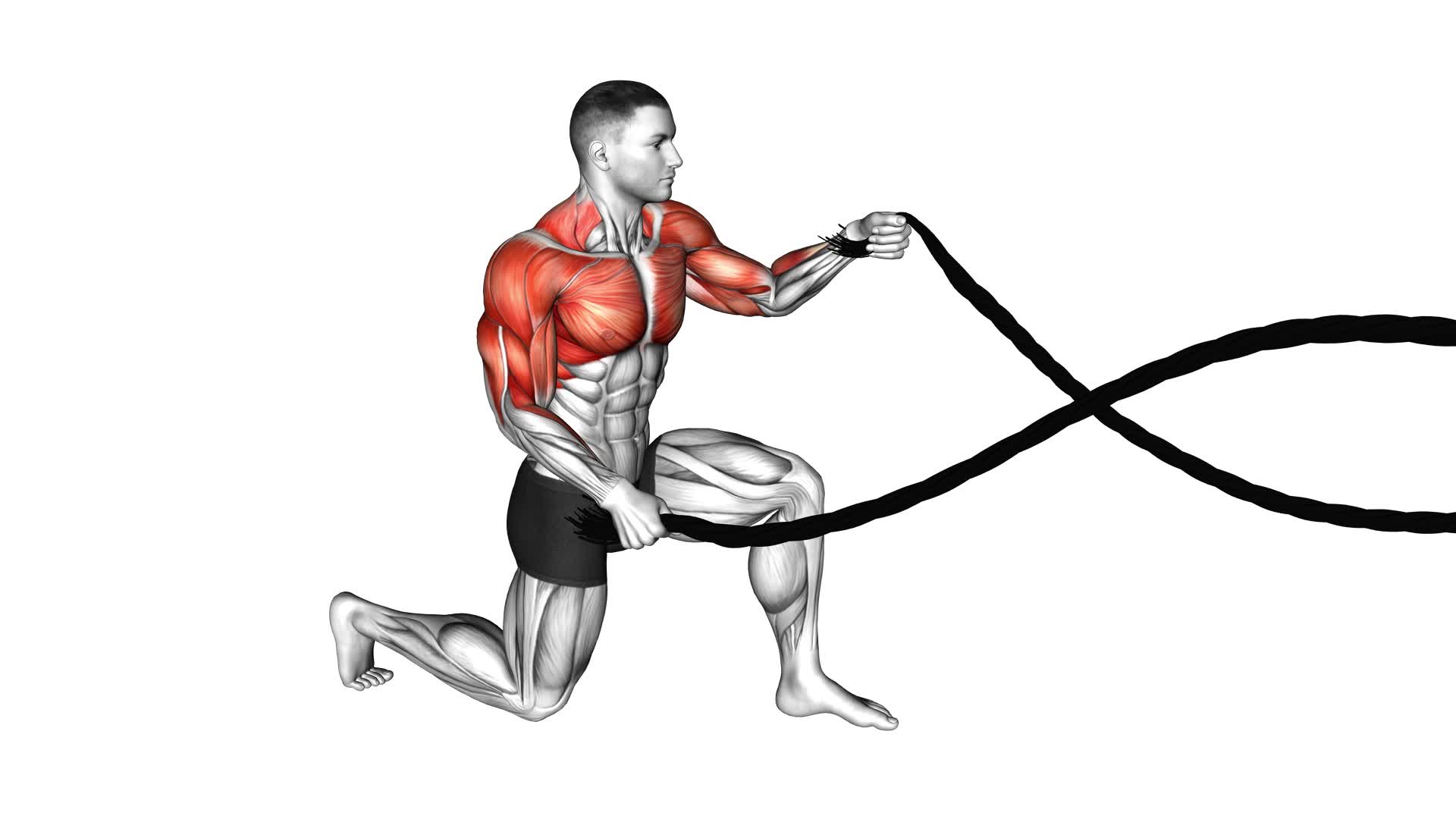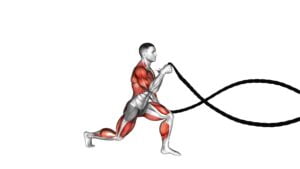Battling Ropes Half Kneeling – Video Exercise Guide & Tips

Get ready to take your workout to the next level with Battling Ropes Half Kneeling! In this video exercise guide, we'll show you the proper technique to maximize your results.
Watch This Exercise Video
Discover the benefits of this intense workout and learn how to avoid common mistakes.
Plus, we'll share tips for increasing the intensity and modifications for different fitness levels.
Get ready to challenge yourself and achieve new fitness goals with Battling Ropes Half Kneeling. Let's get started!
Key Takeaways
- Proper technique for battling ropes half kneeling includes kneeling on one leg, grabbing the ropes with both hands, maintaining a strong, upright posture, and engaging core muscles.
- Battling ropes half kneeling improves core stability, upper body strength, balance, and overall stability.
- Common mistakes to avoid include relying too much on upper body strength, applying too much tension in the upper body, incorrect foot placement, rushing the exercise, and not focusing on proper form and technique.
- To increase intensity, incorporate higher resistance ropes or increase the speed of movements, try advanced variations, use intervals, push your body by increasing duration and intensity of waves, and challenge your core and upper body strength.
Proper Technique for Battling Ropes Half Kneeling
How can you execute the proper technique for Battling Ropes Half Kneeling?
Half kneeling rope variations are a challenging and effective way to engage your core, improve stability, and build upper body strength.
To perform this exercise correctly, start by kneeling on one leg with your other foot planted firmly on the ground. Grab the battling ropes with both hands and keep your elbows slightly bent.
Begin by creating waves in the ropes, alternating between your left and right arms. Make sure to maintain a strong, upright posture throughout the exercise. Engage your core muscles to stabilize your body as you create continuous waves with the ropes.
Keep your movements controlled and rhythmic, focusing on generating power from your upper body and core. By performing battling ropes half kneeling, you not only target your upper body muscles but also challenge your balance and core stability.
This exercise can help improve your overall strength, endurance, and power.
Benefits of Battling Ropes Half Kneeling
To experience the benefits of Battling Ropes Half Kneeling, focus on engaging your core, building upper body strength, and improving stability. This exercise is highly effective in improving core stability and increasing upper body strength. By performing the exercise in a half kneeling position, you're forced to engage your core muscles to maintain balance and control throughout the movement. This not only helps to strengthen your core muscles, but also improves your overall stability and balance.
Additionally, Battling Ropes Half Kneeling targets your upper body, specifically the muscles in your arms, shoulders, and back. The constant movement of the ropes requires you to exert force from your upper body, which helps to build strength and endurance in these muscles. With regular practice, you'll notice increased upper body strength and improved muscular definition.
Furthermore, the dynamic nature of Battling Ropes Half Kneeling provides a cardiovascular workout, helping to increase your heart rate and improve your overall cardiovascular fitness. This makes it a great exercise for burning calories and improving your overall fitness levels.
In conclusion, Battling Ropes Half Kneeling offers numerous benefits, including improved core stability, increased upper body strength, and enhanced cardiovascular fitness. By incorporating this exercise into your routine, you can reap the rewards of a stronger, more stable, and fitter body.
Now, let's move on to discussing common mistakes to avoid when performing this exercise.
Common Mistakes to Avoid
To avoid making common mistakes while performing Battling Ropes Half Kneeling, focus on maintaining proper form and technique.
One of the most common mistakes is using too much upper body strength and not engaging the core muscles. Remember to initiate the movement from your hips, keeping them stable and your abs tight.
Another mistake to watch out for is using too much tension in your upper body, which can lead to shoulder and neck strain. Instead, focus on relaxing your shoulders and keeping your arms loose, allowing the ropes to move freely.
Additionally, be mindful of your foot placement. Keep your front knee directly above your ankle and your back knee hovering just above the ground. This will ensure proper alignment and prevent unnecessary strain on your joints.
Lastly, avoid rushing the exercise. Take your time and focus on maintaining a controlled and smooth rhythm.
By correcting these common mistakes, you'll be able to perform Battling Ropes Half Kneeling with proper form and technique, maximizing the benefits of this exercise.
Now, let's move on to some tips for increasing the intensity.
Tips for Increasing Intensity
To increase the intensity of your Battling Ropes Half Kneeling workout, incorporate higher resistance ropes or increase the speed of your movements. Advanced variations of the Battling Ropes Half Kneeling exercise can be used to further challenge your muscles and elevate your heart rate. One advanced variation is the Alternating Waves, where you perform the exercise with one arm at a time, increasing the demand on your core and upper body strength. Another advanced variation is the Power Slams, where you slam the ropes down forcefully, engaging your entire body and generating maximum power.
Incorporating intervals into your Battling Ropes Half Kneeling workout is another effective way to increase intensity. By alternating between short bursts of high-intensity exercises and periods of rest or lower intensity, you can push your body to work harder and burn more calories. For example, you can perform 20 seconds of fast and intense waves, followed by 10 seconds of rest, and repeat this cycle for a set duration.
Modifications for Different Fitness Levels
To modify the Battling Ropes Half Kneeling exercise for different fitness levels, you can adjust the rope resistance or vary the duration and intensity of the intervals. For beginners or those new to the exercise, it's recommended to start with a lighter rope resistance. This can be achieved by using a thinner or shorter rope. Scaling options for beginners also include reducing the duration and intensity of the intervals. For example, you can start with shorter intervals, such as 15 seconds of work followed by 45 seconds of rest, and gradually increase the intensity and duration as you progress.
On the other hand, advanced variations are available for experienced athletes who want to challenge themselves further. One option is to increase the rope resistance by using a thicker or longer rope. This will require more strength and power to move the ropes. Another advanced variation is to increase the duration and intensity of the intervals. You can try longer work intervals, such as 30 seconds of work followed by 30 seconds of rest, or even eliminate the rest periods altogether for a more intense workout.
Remember to always listen to your body and adjust the exercise accordingly. It's important to find the right balance between challenge and safety to prevent injury and maximize results.
Frequently Asked Questions
How Long Should I Perform the Battling Ropes Half Kneeling Exercise to See Results?
To see results from the battling ropes half kneeling exercise, it's important to focus on the number of sets and reps. Aim for 3-4 sets of 10-15 reps to start. As you progress, increase the intensity and duration of the exercise.
This exercise offers several benefits, such as improving core stability, increasing upper body strength, and enhancing cardiovascular endurance. Consistency and proper form are key to achieving the desired results.
Can I Perform the Battling Ropes Half Kneeling Exercise if I Have a Pre-Existing Shoulder Injury?
If you have a pre-existing shoulder injury, it's important to modify the Battling Ropes Half Kneeling exercise to avoid further damage. This exercise puts a lot of strain on your shoulders, so it may not be suitable for your condition.
Instead, consider alternative exercises that place less stress on your shoulders, such as resistance band exercises or seated cable rows.
Always consult with a healthcare professional before starting any new exercise routine.
Is It Necessary to Use a Specific Type of Rope for the Battling Ropes Half Kneeling Exercise?
When performing the battling ropes half kneeling exercise, you may wonder if it's necessary to use a specific type of rope. The choice of rope can impact the benefits you get from the exercise.
Different ropes provide varying levels of resistance and grip strength requirements. Using a thicker or heavier rope can increase the intensity of the workout.
However, it's important to avoid common mistakes such as using a rope that's too heavy or not maintaining proper form to prevent injury.
How Often Should I Incorporate the Battling Ropes Half Kneeling Exercise Into My Workout Routine?
To get the most out of your workout routine, it's important to know how often to incorporate the battling ropes half kneeling exercise.
This exercise offers numerous benefits, such as improving core stability and strength, increasing cardiovascular endurance, and enhancing overall power and explosiveness.
To reap these benefits, aim to include the battling ropes half kneeling exercise in your workout routine at least 2-3 times per week.
Remember to consult with a fitness professional to tailor the frequency to your specific fitness goals.
Can I Perform the Battling Ropes Half Kneeling Exercise if I Have Limited Space at Home or in the Gym?
If you have limited space at home or in the gym, there are modifications and alternatives for the battling ropes exercise. You can try using a shorter length of rope or using resistance bands instead. These modifications can still provide a great upper body and core workout.
Additionally, you can perform other exercises that target similar muscle groups, such as push-ups or plank variations, to achieve a similar training effect.
Conclusion
In conclusion, battling ropes half kneeling is a challenging exercise that offers numerous benefits for your fitness routine. By using proper technique and avoiding common mistakes, you can maximize the effectiveness of this exercise.
Additionally, incorporating modifications and tips for increasing intensity can help cater to different fitness levels. Whether you're a beginner or an advanced athlete, battling ropes half kneeling can be a valuable addition to your workout routine.

Author
Years ago, the spark of my life’s passion ignited in my mind the moment I stepped into the local gym for the first time. The inaugural bead of perspiration, the initial endeavor, the very first surge of endorphins, and a sense of pride that washed over me post-workout marked the beginning of my deep-seated interest in strength sports, fitness, and sports nutrition. This very curiosity blossomed rapidly into a profound fascination, propelling me to earn a Master’s degree in Physical Education from the Academy of Physical Education in Krakow, followed by a Sports Manager diploma from the Jagiellonian University. My journey of growth led me to gain more specialized qualifications, such as being a certified personal trainer with a focus on sports dietetics, a lifeguard, and an instructor for wellness and corrective gymnastics. Theoretical knowledge paired seamlessly with practical experience, reinforcing my belief that the transformation of individuals under my guidance was also a reflection of my personal growth. This belief holds true even today. Each day, I strive to push the boundaries and explore new realms. These realms gently elevate me to greater heights. The unique combination of passion for my field and the continuous quest for growth fuels my drive to break new ground.



